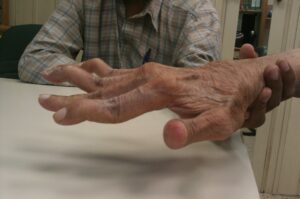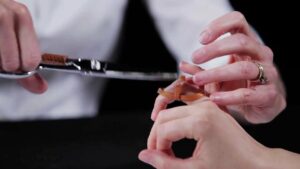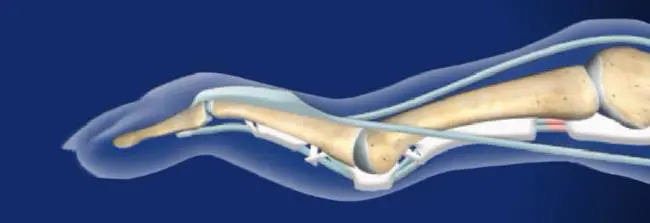Swan neck deformity of the finger is a problem that can afflict both children and adults. It’s a condition in which the neck of the finger bends backward so that it looks like a Swan’s neck. This can lead to problems with dexterity, movement, and joint function. If you or someone you know is suffering from this condition, there are some things you can do to improve your quality of life. In this blog post, we will explore all you need to know about this issue and what you can do to get relief.
Contents
What is Swan Neck Deformity of the Finger?

Swan neck deformity of the finger is a condition in which the distal end of the middle finger protrudes significantly beyond the ring and little fingers. The deformity often results from an obstruction to blood flow in the hand, usually caused by a birth defect or other medical problem. Swan neck deformity of the finger can be quite noticeable and may cause difficulty gripping objects and performing tasks that require fine motor skills. Treatment typically involves surgery to remove the obstruction.
The origin of the name “swan neck” is unclear, but it likely refers to the graceful curve of the finger in question. Swan neck deformity of the finger is a relatively rare condition, and most cases are not associated with any significant problems. However, if the deformity is severe, it can be difficult to perform activities that require fine motor skills or grip strength.
The Types of Swan Neck Deformity of the Finger
There are different types of Swan Neck deformity of the finger. All of them cause discomfort and pose various health risks. Let’s take a look at each type:
1) Congenital Swan Neck Deformity: This is the most common form of Swan Neck Deformity and affects about one in every 1,000 babies. It occurs when the muscles that hold the neck in place don’t form properly during development. As a result, the neck hyperextends (widens) and curves downward, causing the fingers to curl inward (underneath). This condition can be corrected with surgery, but it often leads to difficulties gripping objects and performing other activities.
2) Erb-Duchenne Syndrome: Erb-Duchenne Syndrome is a rare genetic disorder that causes weakness in many areas of the body, including the hand and arm. In some cases, this can lead to Swan Neck deformity of the finger. Symptoms include difficulty opening hands and fingers wide enough to grasp objects, difficulty using joints below the hand (such as wrists), and decreased range of motion in those joints. Treatment typically includes physical therapy and surgery to realign bones and muscles.
3) Amniotic Band Syndrome: Amniotic Band Syndrome is another rare condition caused by problems during childbirth. Usually diagnosed in pre-teens or young adults, this syndrome occurs when bands of muscle fibers (amniotes) wrap around bones near joints (a process called intramembranous ossification). The bands can cause abnormalities in the shape and movement of fingers, hands, and arms. Treatment typically includes surgery to remove the amniotic bands and restore normal joint function.
4) Stenosing Tenosynovitis: Stenosing Tenosynovitis is a type of tenosynovitis (inflammation of a tendon), which can occur in the hand, arm, or shoulder. In the hand, it most often affects the tendons that attach the thumb to the index finger (the “pinky” finger). Symptoms include pain, swelling, and limited range of motion. Treatment typically includes antibiotics and physical therapy.
5) Dupuytren’s Contracture: Dupuytren’s Contracture is a condition caused by tight fibrous bands (tendons) that build up in the hand and trigger pain and stiffness. The bands usually develop over time and become worse as you age. They can restrict movement in various joints in your hand, making it difficult to do basic tasks like gripping objects or typing. Treatment typically involves stretching exercises and surgery to remove the bandages or cut through the tendon.
Symptoms of Swan Neck Deformity of the Finger

If you have a Swan Neck deformity of the finger, it can significantly impact your day-to-day life. The condition is caused by a curved or rotated joint at the base of the finger, resulting in a limited range of motion and difficulty gripping objects. Symptoms can include:
Poor grip strength
One of the main signs of Swan Neck deformity is decreased grip strength. This can make it difficult to hold onto objects, pick up small items, or perform other tasks that require good hand-eye coordination.
Limited range of motion
A Swan Neck deformity of the finger can also limit your range of motion. This means that you may have difficulty moving the joint in all directions, which can make everyday tasks more difficult, such as opening a door or gripping a screwdriver.
Tingling and numbness
In some cases, people with Swan Neck deformity of the finger experience tingling and numbness in the fingers. This is due to restricted blood flow in the arm and hand, which can cause Muscle spasms and reduced sensation.
Inability to fully extend the finger
One of the most significant signs of Swan Neck deformity is difficulty extending the finger fully. This can make it difficult to do tasks such as picking up a pen or opening a door, as you may have to stretch your hand further than you are comfortable with.
Increased pronation/supination (rolling) of the fingers
The increased pronation/supination (rolling) of the fingers can also be a sign of Swan Neck deformity. This means that the fingertips will move more easily in a circular motion, which can be difficult to control and can lead to injury.
Difficulty extending the finger past its normal position
One of the most significant signs of Swan Neck deformity is difficulty extending the finger past its normal position. This can make it difficult to do tasks such as picking up a pen or opening a door, as you may have to stretch your hand further than you are comfortable with.
Pain when trying to grip objects
Some people with Swan Neck deformity of the finger experience pain when trying to grip objects. This is due to the limited range of motion and difficulty gripping objects with the affected hand.
Reduced flexibility in the hand
An isolated Swan Neck deformity of the finger can lead to reduced flexibility in the hand, which can make it difficult to do certain tasks, such as gripping objects.
Reasons for Swan Neck Deformity of the Finger
Swan neck deformity of the finger is a medical condition that can cause difficulty moving the fingers and hand. This deformity occurs when an individual’s neck muscle becomes too tight, which can compress the spinal cord in the neck. This compression can cause various problems with movement in the fingers and hand, including Swan Neck Deformity of the Finger.
Some of the other reasons for Swan’s Neck Deformity of the Finger can be:
Congenital
One of the most common reasons for Swan’s Neck Deformity of the Finger is a congenital condition, which means it is present from birth. In this case, the abnormality is usually caused by something that happened during development in the womb such as malformation or abnormal positioning of the joints.
Rheumatoid Arthritis
Another common cause of Swan Neck Deformity of the Finger is Rheumatoid Arthritis (RA). RA causes inflammation and damage to connective tissues in the body including those found around joints. This can lead to abnormal movement of these joints which can result in deformities like Swan Neck Deformity of the Finger.
Injury
In some cases, an injury may be responsible for causing Swan Neck Deformity of the Finger. A traumatic injury to the hand or fingers can cause damage to joint ligaments, which can lead to abnormal positioning of the finger joints and Swan Neck Deformity of the Finger.
An accident, fall, or another traumatic event can also lead to Swan Neck Deformity of the Finger as it can cause damage to joints and ligaments in the hands and fingers. It may also cause muscle tightness or spasms, which can further contribute to the deformity.
Treatment for Swan Neck Deformity of the Finger

If you have a Swan Neck Deformity of the Finger, then you are not alone. This condition is caused by malformation of the humerus (upper arm bone) and can cause significant problems with the range of motion, strength, and Dexterity. However, there is hope! Treatment options include surgery, physical therapy, and rehabilitation.
In most cases, surgery is the best option for correcting Swan’s Neck Deformity of the Finger. Surgery may involve either a decompression or reconstruction procedure. A decompression procedure involves pressing down on the affected area to release pressure and allow improvement in the range of motion. Reconstruction involves building up the surrounding tissue to restore normal function.
Physical therapy can be extremely helpful in improving the range of motion and strength in Swan’s Neck Deformity of the Finger. Rehabilitation helps improve functionality by teaching patients how to use their arms properly again. There is no one-size-fits-all approach to treatment for this condition; each person will require different levels of treatment based on their situation and symptoms. However, together these treatments can help make a big difference in your quality of life.
Another treatment option is bracing. Bracing can help stabilize the arm and help improve the range of motion. If surgery is not an option or if physical therapy or rehabilitation is not working well, bracing may be a good option for you.
Can You Prevent It?
Swan neck deformity of the finger is a condition where the neck of the finger becomes curved, often causing difficulty gripping objects or typing. Furthermore, The most common cause of this deformity is an abnormal curvature of the radius bone, which attaches the hand to the forearm. Swan neck deformity can also be caused by other medical conditions, such as rheumatoid arthritis and lupus erythematosus.
There are several ways to prevent the Swan Neck Deformity of the Finger. Some of these are:
Exercising Regularly
One of the best ways to prevent Swan Neck Deformity of the Finger is to exercise regularly. Exercise can help to improve your flexibility, which in turn can reduce the chance of developing this condition.
Wearing Supportive Gloves
Wearing supportive gloves can also help to prevent the Swan Neck Deformity of the Finger. Furthermore, These gloves help to support the index finger and keep it from becoming curved.
Consulting with a Healthcare Professional
If you are experiencing difficulty gripping objects or typing, it is important to consult with a healthcare professional. He or she may be able to provide you with recommendations on how to prevent the Swan Neck Deformity of the Finger. Also, your healthcare professional may be able to provide you with treatments available to help improve the condition.
Conclusion
If you’re a musician, singer, or just someone who uses their fingers a lot, then you might be familiar with the Swan Neck Deformity of the Finger. This issue is caused by the curvature of the radius bone in your hand (the same bone that makes your thumb) which can make it difficult to move your fingers properly. Fortunately, there are many treatment options available to help resolve this condition and restore finger mobility. If you would like more information on how to treat this condition or if you are looking for advice from an experienced doctor, please contact us today.
Physical Therapy help patients recover from pain. If you’re experiencing Back pain, Shoulder pain, Knee pain, Neck pain, Elbow pain, Hip pain, or Arthritis pain, a physical therapist at MantraCare can help: Book a physiotherapy session.


